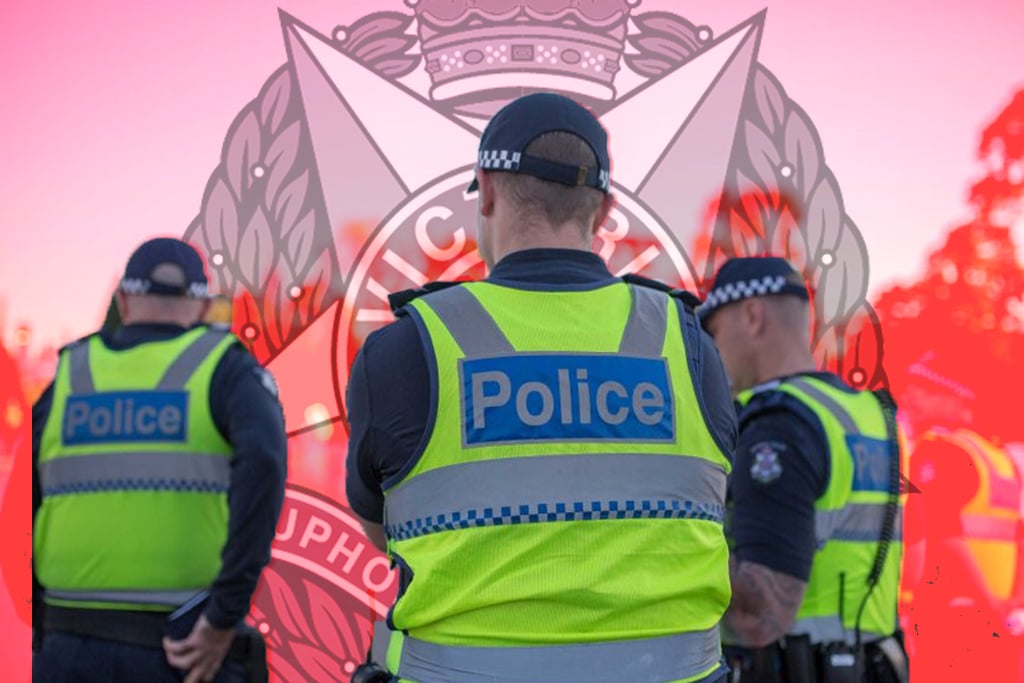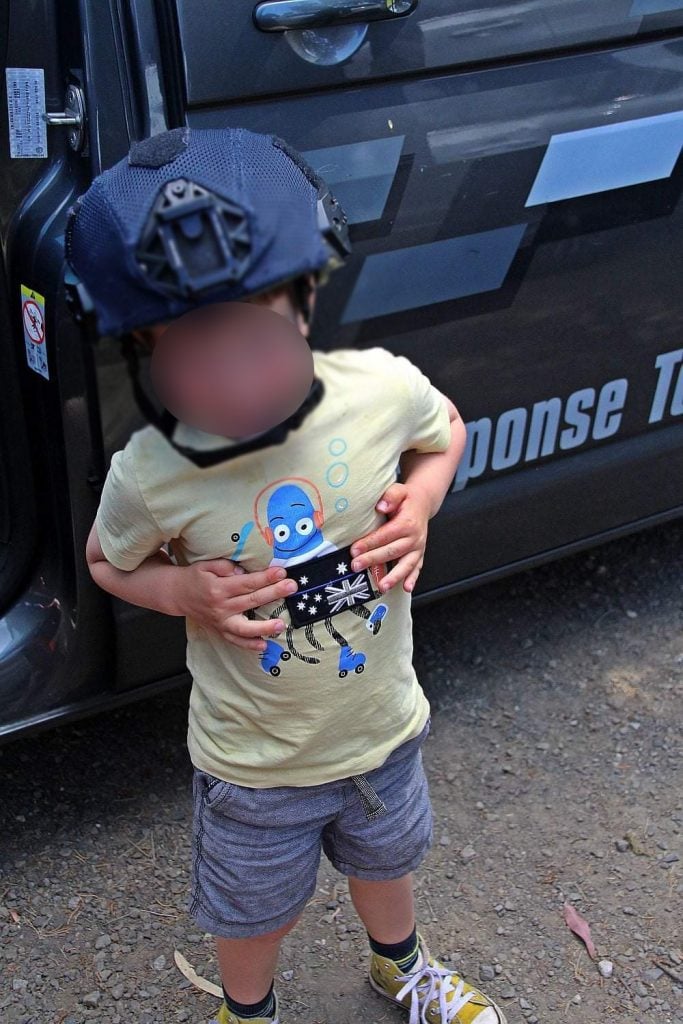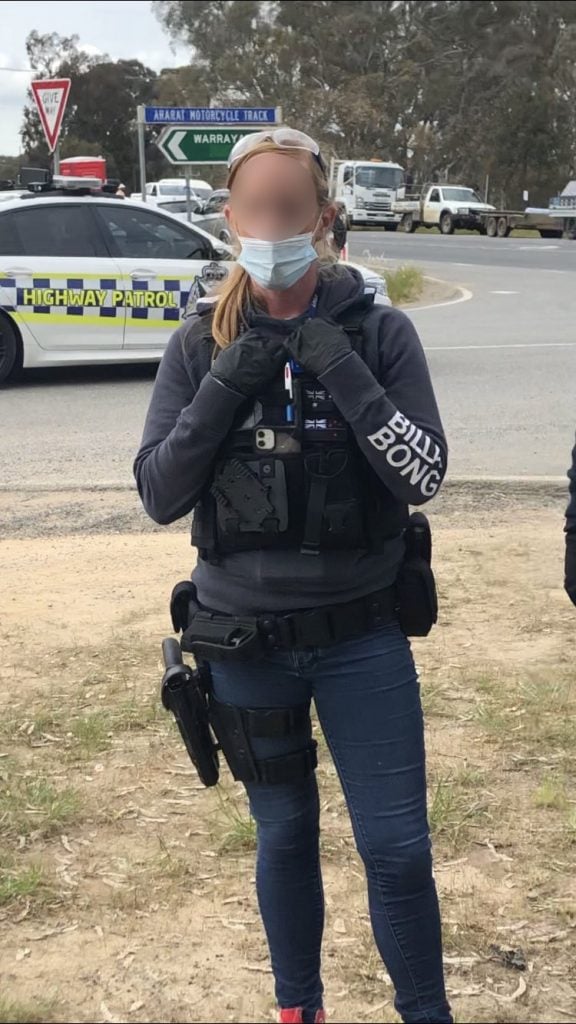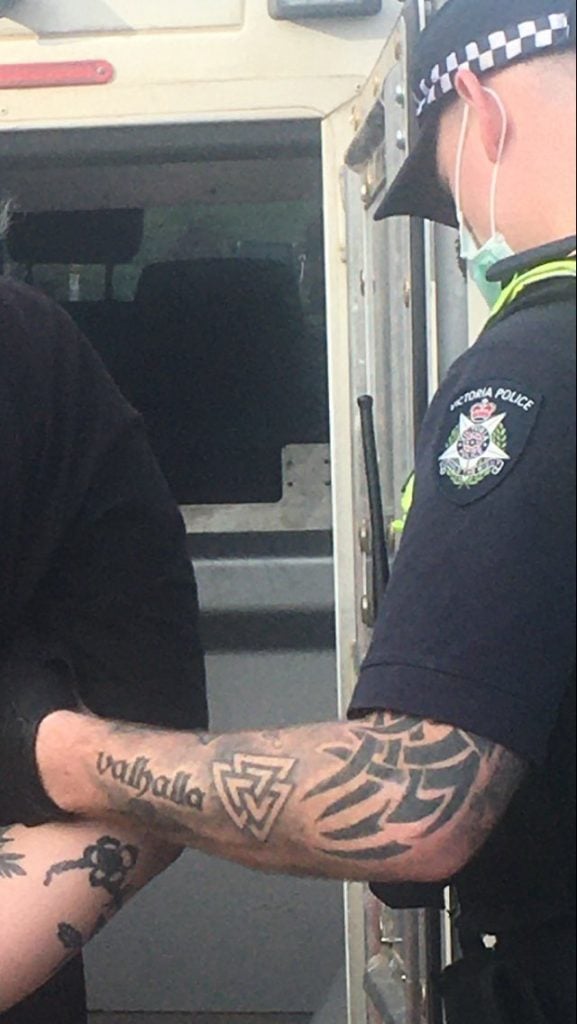Why Do The Victorian Police Keep Getting Caught With Far-Right Associated Symbols?
We know what the symbols mean. So what is VicPol doing about it?

Police are supposed to protect all of us. They’re some of the only civilians we allow to use violence in the name of peace and, from a young age, we’re taught that we can always go to them for help. But at times, their actions — and the lack of condemnation from their superiors — can make it seem like not everyone is, in fact, under their protection.
Victoria Police have been spotted with imagery associated with the far-right in the past 12 months, fuelling concerns of poor attitudes towards minorities from within the force.
Officers have been seen, and photographed, with white supremacist-associated imagery on their bodies, uniforms, and vehicles, even when tasked to work on racially sensitive events like Indigenous rights protests — despite the symbols being banned or required to be covered up.
Thin Blue Line patches have been seen multiple times. Tattoos associated with far-right movements have also been spotted, as well as extremist memes on officers’ personal social media accounts. The thin blue line patch is an Australian version of the American pro-police and anti-Black Lives Matter symbol, which is said to symbolise support for police but has also now become synonymous with opposing Black Lives Matter and is flown at racist events. Donald Trump even adopted it to signify his opposition to Black Lives Matter.
Recently, a police officer was photographed handing a Thin Blue Line patch to a child to pose with in Chelsea, in Melbourne’s South East. A Facebook post characterises the interaction as the child “earning his sergeant’s stripes”, but the patch is clearly an Australian flag devoid of all colour but a thin blue line. Victoria Police told Junkee that Thin Blue Line patches were not allowed to be worn by officers.

In a response to Junkee’s questions about the incident, Victoria Police said the child was being handed a badge to wear to brighten his day. It did not respond to a question about whether or not VicPol approved of the banned patched being used as a prop.
One example of the patch’s misuse was the “Unite The Right” in rally in Charlottesville, Louisiana, USA, where far-right protestors also flew confederate flags, chanted “Jews will not replace us”, and an alt-right supporter mowed down a group of counter protestors in his car.
Anti-racist activist Tom Tanuki said the Blue Lives Matter and the Thin Blue Line movements were hard to separate from racism.
“It’s a reaction and response to BLM in America. It’s utilised in a way that sits alongside anti-BLM and anti-activist movements in the US,” he said. “It’s increasingly being taken to be an anti-Black rights movements symbol. It symbolises police as the thin blue line between order and chaos.
“It situates Black people as being the chaos. This is straightforward stuff, it’s sometimes outwardly racist but it’s more generally anti-social justice and activist.”
Black Lives Matter is an anti-racism movement, specifically arguing for an end to racist policing. By wearing these patches at events related to BLM, police were sending a message, Mr Tanuki said.

Photo: Renters and Housing Union
Thin Blue Line patches were also spotted at the Djab Wurrung trees protests in October, where the Djapwurrung supporters were fighting to prevent the loss of irreplaceable cultural artefacts, what they say is “genocide in motion”. Police said they briefed officers on the ground about sensitivity, but only about the women’s camp at the Djab Wurrung site and not about the racial conflict at the heart of the protest.
In Brisbane, a police officer was spotted wearing a Thin Blue Line patch at a September Black Lives Matter Rally following the death of Aunty Sherry in police custody. Queensland Police Force said he was told to remove it.
An email purported to be sent by VicPol management banned the wearing of the patch in response to the Queensland incident, citing its association with white supremacists and the far-right.
At the same Djab Wurrung protests, a police officer was spotted with a Valknut tattooed on his forearm. Police told Junkee offensive tattoos must be covered up, but did not respond to a question about the Valknut.

Photo: Renters and Housing Union
A Valknut is a symbol found on historical Viking artifacts, but its original pagan meaning can only be speculated upon.
Anti-hate group ADL says: “Some white supremacists, particularly racist Odinists, have appropriated the Valknut to use as a racist symbol. Often they use it as a sign that they are willing to give their life to Odin, generally in battle.”
The police officer’s tattoo appears alongside another which reads “Valhalla”, the mythical resting place of warriors who fall in battle.
However, ADL says that “non-racist pagans” can also use the symbol, and warn that the context it appears in should be considered.
Mr Tanuki said that the appearance of these two symbols was unlikely to be coincidental.”I can imagine police didn’t realise or dwell on the significance of it and that bloke and his edgelord tattoos, I find it unlikely at the end of the day that officer wouldn’t know that significance,” he said.
“The officers in question have come there to send a message to protestors. The officers in question know what messages they are sending.”
Mr Tanuki said to prevent the behaviour, higher-ups would need to act. “They don’t expect a bad reaction from their managers,” he said. “The officers are showing people what they think of their movements. If they wear a thin blue patch at an Indigenous sovereignty event, we know what they mean.”
Late last year police officer Travis Gray was also spotted giving the OK hand gesture at the violent Blockade IMARC protests, where left-wing protestors attempted to prevent a fossil fuel and mining conference from going ahead.
The OK hand gesture has been coopted by white supremacists as a coded message meaning “it’s OK to be white”. Gray directed the sign to an Asian-Australian woman who was wearing a t-shirt that read “immigrant” in rainbow letters, she told Junkee.
“Travis Gray noticed me looking and he started making faces at me, like taunting me. And then he gave me the OK symbol,” she said. “A couple of minutes later, he came up to me and said: ‘you can take photos, you can take videos. It doesn’t matter, nothing will happen.’ He said he was just checking if I was OK. It felt intimidating.”
A Facebook profile belonging to Gray was discovered soon after and had posted far-right associated memes like Pepe the Frog and Wojak/Feels Guy.
At the time, Victoria Police said they were extremely disappointed and condemned the memes. When asked by Junkee if they had taken any further action against Gray, they said the protestor’s account was unsubstantiated.
Junkee sent a list of questions to Victoria Police about all the images seen in this story. It did not directly respond to each question.
On their own, the patches, stickers, and tattoos would normally not be cause for concern, but given Victoria Police’s record of violence and over-policing towards minorities and protestors, and the added context that officers were reportedly warned about the patch’s association with far-right ideologies, makes the imagery seem more sinister.
The Black Lives Matter movement in Australia is calling for accountability for the deaths in custody and over-policing of Indigenous people. To position this reasonable request as “chaos” as Mr Tanuki put it, shows how the officers may really feel. They may claim ignorance but it is nearly impossible to believe.
If policing is to survive the BLM reckoning and become a force for good for all Australians, officers cannot position themselves as an opposing force to those rightfully calling for justice.
Jim Malo is a journalist with an interest in politics and social justice. He tweets at @thejimmalo.